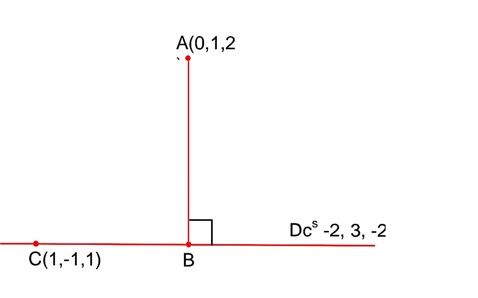Introduction to Three Dimensional Geometry
Get insights from 93 questions on Introduction to Three Dimensional Geometry, answered by students, alumni, and experts. You may also ask and answer any question you like about Introduction to Three Dimensional Geometry
Follow Ask QuestionQuestions
Discussions
Active Users
Followers
New answer posted
2 months agoContributor-Level 10
Direction ratio of line (1, -1, -6)
Equation of line (x−3)/1 = (y+4)/-1 = (z+5)/-6 =k
x=k+3, y=−k−4, z=−6k−5
Solving with plane k=−2
⇒x=1, y=−2, z=7
⇒Distance=√ (3−1)²+6²+3²=√49=7
New answer posted
2 months agoContributor-Level 10
Any point on line (1)
x=α+k
y=1+2k
z=1+3k
Any point on line (2)
x=4+Kβ
y=6+3K
Z=7+3K?
⇒1+2k=6+3K, as the intersect
∴1+3k=7+3K?
⇒K=1, K? =−1
x=α+1; x=4−β
⇒y=3; y=3
z=4; z=4
Equation of plane
x+2y−z=8
⇒α+1+6−4=8 . (i)
and 4−β+6−4=8 . (ii)
Adding (i) and (ii)
α+5−β+12−8=16
α−β+17=24
⇒α−β=7
New answer posted
2 months agoContributor-Level 10
f (x)= {sinx, 0≤xπ}
f' (x)= {cosx, 0
f' (π/2? ) = 0
f' (π/2? ) = 0
f' (π? ) = 0
f' (π? ) = 0
⇒ f (x) is differentiable in (0, ∞)
New answer posted
3 months agoContributor-Level 10
Let direction ratio of the normal to the required plane are l, m, n
Equation of required plane
11 (x – 1) + 1 (y – 2) + 17 (z + 3) = 0
New answer posted
3 months agoContributor-Level 10
Any point on line
5r + 12 = 17
r = 1
New answer posted
3 months agoContributor-Level 10
For 'B', x = 2r + 1, y = 3r – 1, z = -2r + 1
As AB is perpendicular to the line,
->
direction ratios of AB
(2r + 1, 3r – 2, -2r – 1)
Equation of AB
New answer posted
3 months agoContributor-Level 10
l + m – n = 0
l + m = n . (i)
l2 + m2 = n2
Now from (i)
l2 + m2 = (l + m)2
->2lm = 0
->lm = 0
l = 0 or m = 0
->m = n Þ l = n
if we take direction consine of line
cos α =
New answer posted
3 months agoContributor-Level 9
Equation of plane is 3x – 2y + 4z – 7 +
It passes through (1, 4, -3) and we get
Taking an Exam? Selecting a College?
Get authentic answers from experts, students and alumni that you won't find anywhere else
Sign Up on ShikshaOn Shiksha, get access to
- 65k Colleges
- 1.2k Exams
- 679k Reviews
- 1800k Answers

